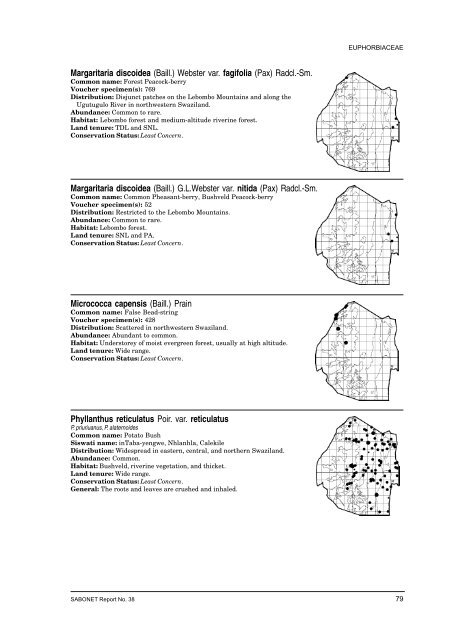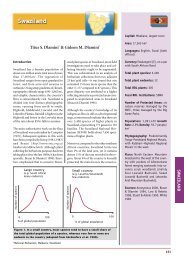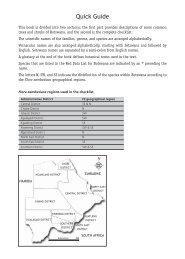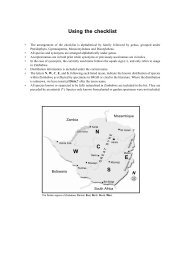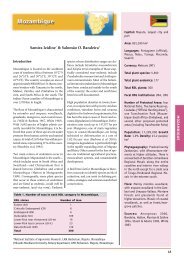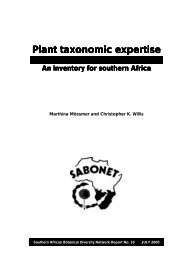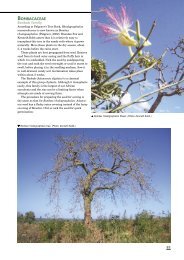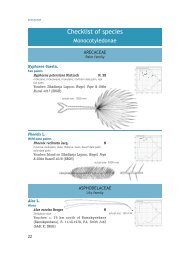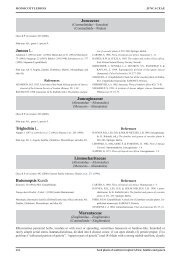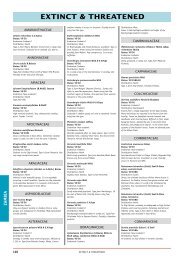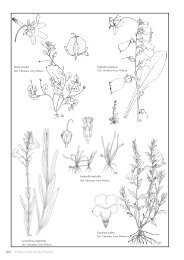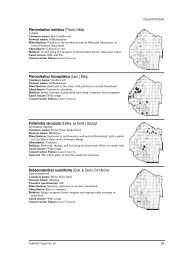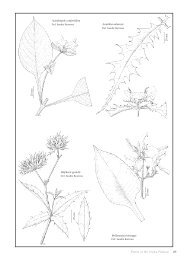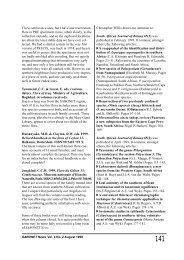Margaritaria discoidea (Baill.) Webster var. fagifolia ... - SABONET
Margaritaria discoidea (Baill.) Webster var. fagifolia ... - SABONET
Margaritaria discoidea (Baill.) Webster var. fagifolia ... - SABONET
You also want an ePaper? Increase the reach of your titles
YUMPU automatically turns print PDFs into web optimized ePapers that Google loves.
<strong>Margaritaria</strong> <strong>discoidea</strong> (<strong>Baill</strong>.) <strong>Webster</strong> <strong>var</strong>. <strong>fagifolia</strong> (Pax) Radcl.-Sm.<br />
Common name: Forest Peacock-berry<br />
Voucher specimen(s): 769<br />
Distribution: Disjunct patches on the Lebombo Mountains and along the<br />
Ugutugulo River in northwestern Swaziland.<br />
Abundance: Common to rare.<br />
Habitat: Lebombo forest and medium-altitude riverine forest.<br />
Land tenure: TDL and SNL.<br />
Conservation Status: Least Concern.<br />
<strong>Margaritaria</strong> <strong>discoidea</strong> (<strong>Baill</strong>.) G.L.<strong>Webster</strong> <strong>var</strong>. nitida (Pax) Radcl.-Sm.<br />
Common name: Common Pheasant-berry, Bushveld Peacock-berry<br />
Voucher specimen(s): 52<br />
Distribution: Restricted to the Lebombo Mountains.<br />
Abundance: Common to rare.<br />
Habitat: Lebombo forest.<br />
Land tenure: SNL and PA.<br />
Conservation Status: Least Concern.<br />
Micrococca capensis (<strong>Baill</strong>.) Prain<br />
Common name: False Bead-string<br />
Voucher specimen(s): 428<br />
Distribution: Scattered in northwestern Swaziland.<br />
Abundance: Abundant to common.<br />
Habitat: Understorey of moist evergreen forest, usually at high altitude.<br />
Land tenure: Wide range.<br />
Conservation Status: Least Concern.<br />
Phyllanthus reticulatus Poir. <strong>var</strong>. reticulatus<br />
P. priuriuanus, P. alaternoides<br />
Common name: Potato Bush<br />
Siswati name: inTaba-yengwe, Nhlanhla, Calekile<br />
Distribution: Widespread in eastern, central, and northern Swaziland.<br />
Abundance: Common.<br />
Habitat: Bushveld, riverine vegetation, and thicket.<br />
Land tenure: Wide range.<br />
Conservation Status: Least Concern.<br />
General: The roots and leaves are crushed and inhaled.<br />
EUPHORBIACEAE<br />
<strong>SABONET</strong> Report No. 38 79
EUPHORBIACEAE<br />
*Ricinus communis L.<br />
Common name: Castor Oil Bush<br />
Siswati name: umHlafutfo<br />
Distribution: Widespread throughout most of Swaziland.<br />
Abundance: Common to abundant.<br />
Habitat: River banks, wastelands, disturbed areas, and along roadsides in a<br />
wide <strong>var</strong>iety of habitats.<br />
Land tenure: Wide range.<br />
Legal status: Declared Invader.<br />
General: The leaves are used to treat open wounds and the fruit is used for<br />
the oil.<br />
Sclerocroton integerrimum Hochst.<br />
Sapium integerrimum, S. reticulatum<br />
Common name: Duikerberry<br />
Siswati name: umHlalampunzi<br />
Distribution: Isolated patches in central Swaziland and near Herefords in<br />
the north.<br />
Abundance: Rare to common.<br />
Habitat: Riverine thicket and bushveld at medium altitude.<br />
Land tenure: Wide range.<br />
Conservation Status: Least Concern.<br />
Shirakiopsis elliptica (Hochst.) Esser<br />
Sapium ellipticum<br />
Common name: Jumping-seed Tree<br />
Siswati name: umHlepha<br />
Voucher specimen(s): 644, 716<br />
Distribution: Sparsely scattered in northern, central-western, and southwestern<br />
Swaziland, with an isolated patch near Dingindlovu River in the<br />
Lebombo Mountains.<br />
Abundance: Common to rare.<br />
Habitat: Riverine vegetation, forest margins, wooded ravines, and rocky<br />
outcrops in grassland.<br />
Land tenure: Wide range.<br />
Conservation Status: Least Concern.<br />
Spirostachys africana Sond.<br />
Common name: Tamboti, Jumping-bean Tree<br />
Siswati name: umTfombotsi<br />
Distribution: Widespread in central and eastern Swaziland.<br />
Abundance: Common to abundant.<br />
Habitat: Bushveld, thicket, and woodland. Often forming dense stands along<br />
drainage lines on heavy soils.<br />
Land tenure: Wide range.<br />
Conservation Status: Least Concern.<br />
General: The wood is used for timber, cattle kraals and furniture, and the<br />
bark for deworming.<br />
80 <strong>SABONET</strong> Report No. 38
Suregada africana (Sond.) Kuntze<br />
Common name: Common Canary-berry<br />
Siswati name: siTfubi, Manyokane, Vulabahleke<br />
Voucher specimen(s): 756<br />
Distribution: Sparsely scattered in eastern, northern, central, and western<br />
Swaziland.<br />
Abundance: Common.<br />
Habitat: Bushveld, forest, riverine thickets, and wooded grassland.<br />
Land tenure: Wide range.<br />
Conservation Status: Least Concern.<br />
General: The roots are used as a charm to make people laugh.<br />
Suregada procera (Prain) Croizat<br />
Gelonium procerum<br />
Common name: Forest Canary-berry<br />
Voucher specimen(s): 692<br />
Distribution: Isolated patch on the Ugutugulo River in northwestern<br />
Swaziland.<br />
Abundance: Common.<br />
Habitat: Medium-altitude riverine forest.<br />
Land tenure: TDL.<br />
Conservation Status: Should be considered for Near Threatened status.<br />
General: The area is threatened by alien weed infestation, especially<br />
Chromolaena odorata and Lantana camara.<br />
Synadenium cupulare (Boiss.) L.C.Wheeler<br />
Common name: Dead-man’s Tree<br />
Siswati name: siDletjana<br />
Distribution: Sparsely scattered in northern Swaziland, with an isolated<br />
patch near Jilobi on the Lebombo Range.<br />
Abundance: Rare to common.<br />
Habitat: Bushveld and low-lying riparian vegetation.<br />
Land tenure: Wide range.<br />
Conservation Status: Data Deficient. Should be considered for Least Concern<br />
status.<br />
General: A near endemic (B3). Often found around abandoned homesteads<br />
and kraals. Used medicinally as an eye treatment.<br />
FABACEAE<br />
Acacia ataxacantha D.C.<br />
Common name: Flame Thorn<br />
Siswati name: luGagane<br />
Distribution: Fairly widespread throughout most of Swaziland.<br />
Abundance: Abundant.<br />
Habitat: Often forms impenetrable thickets in riverine vegetation, bushveld,<br />
wooded grassland, along forest margins, and on rocky hillsides.<br />
Land tenure: Wide range.<br />
Conservation Status: Least Concern.<br />
General: The branches are used for making crafts.<br />
EUPHORBIACEAE<br />
<strong>SABONET</strong> Report No. 38 81
FABACEAE<br />
Acacia borleae Burtt Davy<br />
Common name: Sticky Thorn<br />
Siswati name: luBibi, Sitfwetfwe<br />
Voucher specimen(s): 1008<br />
Distribution: Restricted to central-eastern Swaziland near Mpaka and<br />
Hlane.<br />
Abundance: Common.<br />
Habitat: Dry bushveld and low-lying riverine fringe thicket. Often on alluvial<br />
soils.<br />
Land tenure: Wide range.<br />
Conservation Status: Least Concern.<br />
Acacia brevispica Harms subsp. dregeana (Benth.) Brenan<br />
Common name: Prickly Thorn<br />
Siswati name: luGagane<br />
Voucher specimen(s): 730<br />
Distribution: Scattered in eastern and central Swaziland.<br />
Abundance: Common.<br />
Habitat: Dry bushveld, forest, and along drainage lines.<br />
Land tenure: Wide range.<br />
Conservation Status: Least Concern.<br />
Acacia burkei Benth.<br />
Common name: Black Monkey Thorn<br />
Siswati name: umKhaya, Umbambampala, Sikhayane, umGamba<br />
Distribution: Scattered in central and eastern Swaziland.<br />
Abundance: Common.<br />
Habitat: Dry bushveld, woodland, and thicket. Often on sandy soils.<br />
Land tenure: Wide range.<br />
Conservation Status: Least Concern.<br />
General: This species is <strong>var</strong>iable with at least two forms occurring in<br />
Swaziland: a small-leaved <strong>var</strong>iety and a large-leaved one. Further investigation<br />
is required to determine whether they co-exist. The branches are<br />
used for firewood.<br />
Acacia caffra (Thunb.) Willd.<br />
Common name: Common Hook Thorn<br />
Siswati name: umTfololwane, umGamba, luGagane, iSinga<br />
Voucher specimen(s): 802, 930, 1002<br />
Distribution: Scattered throughout most of Swaziland.<br />
Abundance: Common.<br />
Habitat: Open bushveld, wooded grassland, rocky hillsides, and thicket.<br />
Often near water.<br />
Land tenure: Wide range.<br />
Conservation Status: Least Concern.<br />
General: The branches are used for firewood.<br />
82 <strong>SABONET</strong> Report No. 38
Acacia davyi N.E.Br.<br />
Common name: Corky-bark Thorn<br />
Siswati name: umCamba, Mshipha, umGamba<br />
Distribution: Widespread throughout central, northern, and southwestern<br />
Swaziland and the Lebombo Range.<br />
Abundance: Abundant to common.<br />
Habitat: Open bushveld, wooded grassland, riverine thicket, and on rocky<br />
hillsides.<br />
Land tenure: Wide range.<br />
Conservation Status: Least Concern.<br />
General: The species has a tendency to form colonies and encroach into<br />
surrounding vegetation. The branches are used for firewood.<br />
*Acacia dealbata Link<br />
Common name: Silver Wattle<br />
Siswati name: Umtfolo wesilungu, umGamba<br />
Distribution: Scattered in western Swaziland.<br />
Abundance: Abundant.<br />
Habitat: Forms dense stands along mountain rivers and streams, in grassland,<br />
on road verges, and along forest margins.<br />
Land tenure: Wide range.<br />
Legal status: Declared Invader.<br />
General: Used for firewood and building purposes. It coppices easily and<br />
produces large numbers of seeds that can remain dormant for over 50 years.<br />
Seeds can be dispersed by water and germination is stimulated by fire.<br />
*Acacia decurrens Willd.<br />
Common name: Green Wattle<br />
Siswati name: Umtfolo wesilungu<br />
Distribution: Scattered in the west, with patches in central Swaziland.<br />
Abundance: Abundant.<br />
Habitat: Forms dense stands along mountain rivers and streams, in grassland,<br />
along forest margins, urban areas, and along roadsides.<br />
Land tenure: Wide range.<br />
Legal status: Declared Invader.<br />
General: Used for fuelwood and building purposes. It coppices easily and<br />
produces large numbers of seeds that can remain dormant for well over 50<br />
years. Seeds can be dispersed by water and germination is stimulated by<br />
fire.<br />
Acacia gerrardii Benth. subsp. gerrardii <strong>var</strong>. gerrardii<br />
Common name: Red Thorn<br />
Siswati name: liPhuze, Mbote<br />
Distribution: Fairly widespread in central, eastern, and northern Swaziland.<br />
Abundance: Common.<br />
Habitat: Bushveld, woodland, wooded grassland, and thicket.<br />
Land tenure: Wide range.<br />
Conservation Status: Least Concern.<br />
FABACEAE<br />
<strong>SABONET</strong> Report No. 38 83
FABACEAE<br />
Acacia grandicornuta Gerstner<br />
Common name: Horned Thorn, Hooked Thorn<br />
Siswati name: siTfwetfwe, umGamba<br />
Distribution: Sparsely scattered in the east, with a patch near Thulwane in<br />
central Swaziland.<br />
Abundance: Common.<br />
Habitat: Dry bushveld and thicket and along dry river beds.<br />
Land tenure: Wide range.<br />
Conservation Status: Least Concern.<br />
*Acacia longifolia (Andrews) Willd.<br />
Common name: Sallow Wattle, Golden Wattle<br />
Voucher specimen(s): 726<br />
Distribution: Scattered in northwestern Swaziland.<br />
Abundance: Abundant to common.<br />
Habitat: Moist areas in high altitude grassland, along river banks, and on the<br />
margins of industrial timber plantations.<br />
Land tenure: Wide range.<br />
Legal status: Declared Weed.<br />
General: It is a competitive species forming dense colonies and can rapidly<br />
transform landscapes.<br />
Acacia luederitzii Engl. <strong>var</strong>. retinens (Sim) J.H.Ross & Brenan<br />
Common name: Balloon Thorn<br />
Siswati name: luKakho, Sibambimphala<br />
Voucher specimen(s): 805<br />
Distribution: Scattered in eastern Swaziland.<br />
Abundance: Common.<br />
Habitat: Woodland, dry bushveld, and thicket. Often on deep clay soils.<br />
Land tenure: Wide range.<br />
Conservation Status: Least Concern.<br />
*Acacia mearnsii De Wild.<br />
Common name: Black Wattle<br />
Siswati name: Umtfolo wesilungu, Umgamba<br />
Distribution: Widespread over western Swaziland, with patches on the<br />
Lebombo Range.<br />
Abundance: Abundant.<br />
Habitat: Forms dense stands along mountain rivers and streams, in grassland,<br />
along forest margins, urban areas, wooded grassland, forest clearings,<br />
and along roadsides.<br />
Land tenure: Wide range.<br />
Legal status: Declared Invader.<br />
General: Initially cultivated in woodlots for bark, fuel, and building purposes.<br />
It has now naturalised itself and has become a problem weed. It coppices<br />
easily and produces large numbers of seeds that can remain dormant for<br />
over 50 years. Seeds can be dispersed by water and germination is stimulated by fire.<br />
84 <strong>SABONET</strong> Report No. 38
*Acacia melanoxylon R.Br.<br />
Common name: Blackwood<br />
Siswati name: umTfolo, inGulukane<br />
Distribution: Scattered in northwestern and southwestern Swaziland.<br />
Abundance: Common to abundant.<br />
Habitat: Naturalised in mountain grassland, along forest margins, and in<br />
urban areas.<br />
Land tenure: Wide range.<br />
Legal status: Declared Invader.<br />
General: Used for timber, firewood, and furniture. Regenerates from vigorous<br />
root suckers and stores large quantities of seed in the soil.<br />
FABACEAE<br />
Acacia natalitia E.Mey.<br />
A. karroo in part<br />
Common name: Pale-bark Sweet Thorn<br />
Siswati name: Singa, uMunga, umGamba<br />
Voucher specimen(s): 961<br />
Distribution: Fairly widespread throughout most of Swaziland.<br />
Abundance: Common to abundant.<br />
Habitat: Bushveld, wooded grassland, along forest margins, and in thicket.<br />
Land tenure: Wide range.<br />
Conservation Status: Least Concern.<br />
General: This species is <strong>var</strong>iable and has several forms which were previously<br />
lumped under the A. karroo complex. Further investigation is needed, but it<br />
is likely that A. karroo does not occur in Swaziland. It has more robust pods<br />
than A. natalitia and is restricted to the Karroo and areas directly surrounding<br />
the Karroo (Johan Hurter pers. comm.). In Swaziland, A. natalitia occasionally forms dense thickets in<br />
disturbed and overgrazed areas, encroaching on other vegetation. It is considered an indicator of water in<br />
arid areas and of “sweet veld” where there are good soils and grazing. The bark is used as a diuretic and the<br />
seeds for necklaces.<br />
Acacia nigrescens Oliv.<br />
Common name: Knobthorn<br />
Siswati name: umKhaya, umHlofunga<br />
Distribution: Widespread in eastern and central Swaziland.<br />
Abundance: Abundant to common.<br />
Habitat: A dominant species in Acacia woodland. Also in dry bushveld,<br />
thicket and low-lying riverine fringe thicket.<br />
Land tenure: Wide range.<br />
Conservation Status: Least Concern.<br />
General: Considered an indicator of “sweet veld” where there are usually<br />
good soils and grazing. The trunk is used to make furniture and the bark to<br />
treat fatigue.<br />
Acacia nilotica (L.) Willd. ex Delile subsp. kraussiana (Benth.) Brenan<br />
Common name: Scented-pod Thorn<br />
Siswati name: inShakwe, Sitfetfe, Sitwetwe, Inshagu, umNcawe, Lugagane<br />
Distribution: Widespread in eastern and central Swaziland, with patches in<br />
the west.<br />
Abundance: Abundant to common.<br />
Habitat: Bushveld, thicket, wooded grassland, and low-lying riverine fringe<br />
thicket.<br />
Land tenure: Wide range.<br />
Conservation Status: Least Concern.<br />
General: The species has an encroaching habit and often forms impenetrable<br />
thickets in disturbed and overgrazed areas. The bark and roots are used as<br />
an emetic and the trunk for firewood and construction.<br />
<strong>SABONET</strong> Report No. 38 85
FABACEAE<br />
Acacia robusta Burch. subsp. clavigera (E.Mey.) Brenan<br />
A. clavigera<br />
Common name: River Thorn, Brack Thorn<br />
Siswati name: umGamazi, imGamba, Umngamti, Singa<br />
Distribution: Widespread in eastern and central Swaziland.<br />
Abundance: Common.<br />
Habitat: Low-altitude riparian forest, along drainage lines, and in dry<br />
bushveld and thicket.<br />
Land tenure: Wide range.<br />
Conservation Status: Least Concern.<br />
General: The roots are used for medicinal purposes. The bark is used to treat<br />
hernias and to increase stamina.<br />
Acacia schweinfurthii Brenan & Exell <strong>var</strong>. schweinfurthii<br />
Common name: River Climbing Thorn<br />
Distribution: Sparsely scattered in eastern Swaziland.<br />
Abundance: Common to abundant.<br />
Habitat: Often forming impenetrable thickets in low-lying riverine fringe<br />
vegetation and along dry forest margins.<br />
Land tenure: SNL and TDL.<br />
Conservation Status: Least Concern.<br />
Acacia senegal (L.) Willd. <strong>var</strong>. rostrata Brenan<br />
Common name: Bushy Three-hook Thorn<br />
Siswati name: amBambimphala, umGamba<br />
Distribution: Scattered in eastern Swaziland.<br />
Abundance: Common to abundant.<br />
Habitat: Dry bushveld and thicket. Often on alluvial soils.<br />
Land tenure: Wide range.<br />
Conservation Status: Least Concern.<br />
General: A taller <strong>var</strong>iety of A. senegal has been noted to co-exist in<br />
Swaziland—it is more tree-like and lacks the dense rounded canopy. It is<br />
possible that it is A. senegal <strong>var</strong>. leiorhachis and needs confirmation.<br />
Acacia sieberiana DC. <strong>var</strong>. woodii (Burtt Davy) Keay & Brenan<br />
Common name: Paperbark Thorn<br />
Siswati name: umKhambane, umNganduzi, siTfwetfwe<br />
Distribution: Scattered in northern, central, and southwestern Swaziland,<br />
with a patch near Siteki on the Lebombo Range.<br />
Abundance: Common.<br />
Habitat: Open bushveld, wooded grassland and grassland, often near water.<br />
Land tenure: Wide range.<br />
Conservation Status: Least Concern.<br />
General: The bark is used as an analgesic and for vomiting.<br />
86 <strong>SABONET</strong> Report No. 38
Acacia swazica Burtt Davy<br />
Common name: Swazi Thorn<br />
Siswati name: luBibi, Khalimela, Sitfwetfwe, Sasane, umGamba<br />
Voucher specimen(s): 733<br />
Distribution: Scattered in eastern and central Swaziland.<br />
Abundance: Common to abundant.<br />
Habitat: Dry bushveld, thicket, and on wooded hillsides.<br />
Land tenure: Wide range.<br />
Conservation Status: Least Concern.<br />
General: The bark is used for making rope and the roots for medicinal<br />
purposes.<br />
Acacia tortilis (Forssk.) Hayne subsp. heteracantha (Burch.) Brenan<br />
Common name: Umbrella Thorn<br />
Siswati name: umSasane, liSasa, Sitfetfe, Sasane-lomcane, umGamba<br />
Distribution: Widespread in eastern and central Swaziland.<br />
Abundance: Abundant to common.<br />
Habitat: Dry bushveld, woodland, and thicket.<br />
Land tenure: Wide range.<br />
Conservation Status: Least Concern.<br />
General: The species is considered by farmers to be an indicator of good soils<br />
and grasses. The branches are used for fencing and firewood.<br />
Acacia xanthophloea Benth.<br />
Common name: Fever Tree<br />
Siswati name: umHlafutfwa, umKhanyakudze, Umhlosinga<br />
Distribution: Widespread in the east, with patches in central Swaziland.<br />
Abundance: Common.<br />
Habitat: Dry thicket, bushveld, and in riverine vegetation. Nearly always<br />
associated with water in low-lying areas.<br />
Land tenure: Wide range.<br />
Conservation Status: Least Concern.<br />
General: The wood is used for timber and firewood and the bark for medicinal<br />
purposes.<br />
Adenopodia spicata (E.Mey.) Presl<br />
Entada spicata, E. natalensis<br />
Common name: Spiny Splinter-bean<br />
Voucher specimen(s): 418, 486<br />
Distribution: Scattered in western Swaziland, with a patch near Hluti in the<br />
south.<br />
Abundance: Common.<br />
Habitat: Along moist forest margins and mountain stream banks.<br />
Land tenure: Wide range.<br />
Conservation Status: Least Concern.<br />
FABACEAE<br />
<strong>SABONET</strong> Report No. 38 87
FABACEAE<br />
Afzelia quanzensis Welw.<br />
Common name: Pod Mahogany<br />
Siswati name: umKholikholi<br />
Distribution: Widespread in the Lebombo Range, with patches in northeastern<br />
Swaziland.<br />
Abundance: Common.<br />
Habitat: Dry Lebombo forest, bushveld, and low-altitude woodland.<br />
Land tenure: Wide range.<br />
Conservation Status: Least Concern.<br />
General: The roots and bark are used to treat eczema and bilharzia.<br />
Albizia adianthifolia (Schumach.) W.F.Wight <strong>var</strong>. adianthifolia<br />
Common name: Flat-crown Albizia<br />
Siswati name: liGowane, siVangatane<br />
Distribution: Patches on the Lebombo Range.<br />
Abundance: Common.<br />
Habitat: On rocky slopes in Lebombo bushveld and forest fringes.<br />
Land tenure: SNL.<br />
Conservation Status: Least Concern.<br />
General: The bark is used for treating ulcers in people and scabies in dogs.<br />
Albizia anthelmintica (A.Rich.) Brongn.<br />
Common name: Worm-bark False-thorn, Worm-cure Albizia<br />
Siswati name: umNala, Ligola, iPhulane<br />
Voucher specimen(s): 34<br />
Distribution: Scattered in eastern Swaziland.<br />
Abundance: Common.<br />
Habitat: Dry bushveld and thicket, often on sandy soils and along dry river<br />
beds.<br />
Land tenure: SNL.<br />
Conservation Status: Least Concern.<br />
General: The wood is used for timber and firewood and the bark and roots for<br />
medicinal purposes.<br />
Albizia forbesii Benth.<br />
Common name: Broad-pod False-thorn<br />
Siswati name: umNala<br />
Voucher specimen(s): 356<br />
Distribution: Sparsely scattered in northeastern Swaziland.<br />
Abundance: Rare to common.<br />
Habitat: In bushveld, often on sandy soils.<br />
Land tenure: SNL.<br />
Conservation Status: Least Concern.<br />
88 <strong>SABONET</strong> Report No. 38
Albizia harveyi E.Fourn.<br />
Common name: Bushveld Albizia, Common False-thorn<br />
Siswati name: UmTfolowane, inKhambane<br />
Voucher specimen(s): 947<br />
Distribution: Restricted to northeastern Swaziland.<br />
Abundance: Rare.<br />
Habitat: Dry bushveld and woodland.<br />
Land tenure: TDL and PA.<br />
Conservation Status: Least Concern.<br />
Albizia versicolor Welw. ex Oliv.<br />
Common name: Large-leaved False-thorn<br />
Siswati name: siVangatane<br />
Distribution: Scattered in northern, central, southern, and eastern Swaziland.<br />
Abundance: Common.<br />
Habitat: Woodland and bushveld, often along watercourses.<br />
Land tenure: Wide range.<br />
Conservation Status: Least Concern.<br />
General: The bark is used during sangoma washing ceremonies.<br />
Bauhinia galpinii N.E.Br.<br />
Common name: Pride-of-De Kaap<br />
Siswati name: luSololo<br />
Distribution: Widespread throughout most of Swaziland.<br />
Abundance: Common to abundant.<br />
Habitat: Bushveld, woodland, rocky hillsides, thicket, and along forest margins.<br />
Land tenure: Wide range.<br />
Conservation Status: Least Concern.<br />
General: The roots are used for deworming.<br />
Bolusanthus speciosus (L.Bolus) Harms<br />
Common name: Tree Wistaria<br />
Siswati name: umHhohlo<br />
Distribution: Widespread in eastern and central Swaziland.<br />
Abundance: Common.<br />
Habitat: Bushveld, woodland, and thicket, often on clay soils.<br />
Land tenure: Wide range.<br />
Conservation Status: Least Concern.<br />
General: The wood is termite resistant and much sought-after for timber and<br />
firewood. The bark is used medicinally and roots for treating stomach<br />
complaints.<br />
FABACEAE<br />
<strong>SABONET</strong> Report No. 38 89
FABACEAE<br />
*Caesalpinia decapetala (Roth) Alston<br />
Common name: Mauritius Thorn<br />
Siswati name: luGagane<br />
Distribution: Widespread in central and western Swaziland and scattered<br />
on the Lebombo Range.<br />
Abundance: Abundant.<br />
Calpurnia aurea (Ait.) Benth. subsp. aurea<br />
C. aurea subsp. sylvatica<br />
Common name: Common Calpurnia<br />
Siswati name: umPhendvulo<br />
Voucher specimen(s): 197, 452, 792<br />
Distribution: Scattered along the Lebombo Range, western, and southwestern<br />
Swaziland.<br />
Abundance: Common.<br />
Habitat: Evergreen forest, forest clearings, forest margins, grassland, and<br />
bushveld.<br />
Land tenure: Wide range.<br />
Conservation Status: Least Concern.<br />
Calpurnia glabrata Brummitt<br />
Common name: Swazi Calpurnia<br />
Voucher specimen(s): 331<br />
Distribution: Isolated patches in southwestern Swaziland near Sicunusa<br />
and Gege Border Posts.<br />
Abundance: Common to rare.<br />
Habitat: High-altitude grassland.<br />
Land tenure: SNL.<br />
Conservation Status: Least Concern.<br />
General: A near endemic (B2).<br />
Cordyla africana Lour.<br />
Common name: Wild Mango, Sunbird Tree<br />
Siswati name: Umbubuli, Vovovo, Thunzikhulu<br />
Voucher specimen(s): 665<br />
Distribution: Isolated patch in the Mbuluzi Gorge in the Lebombo Range.<br />
Abundance: Rare.<br />
Habitat: In Androstachys forest on the Lebombo mountains.<br />
Land tenure: PA.<br />
Conservation Status: Least Concern.<br />
General: The bark is used as an emetic.<br />
90 <strong>SABONET</strong> Report No. 38
Craibia zimmermannii (Harms) Dunn<br />
Common name: Peawood, Sandforest Craibia<br />
Voucher specimen(s): 779<br />
Distribution: Restricted to the Manzimyname and Mtibhlati Gorges in the<br />
Lebombo Mountains.<br />
Abundance: Common.<br />
Habitat: Sub-canopy species in Lebombo forest.<br />
Land tenure: TDL and SNL.<br />
Conservation Status: Least Concern.<br />
Crotalaria capensis Jacq.<br />
Common name: Eared Rattle-pod<br />
Siswati name: Bhubhubhu<br />
Voucher specimen(s): 438<br />
Distribution: Patches in northern, central, southern, and eastern Swaziland.<br />
Abundance: Common.<br />
Habitat: In and along the margins of evergreen forest, forest clearings, and<br />
wooded grassland.<br />
Land tenure: Wide range.<br />
Conservation Status: Least Concern.<br />
Crotalaria laburnifolia L. subsp. australis (Baker f.) Polhill<br />
Common name: Brown-and-yellow Rattle-pod<br />
Voucher specimen(s): 362, 807, 817, 929<br />
Distribution: Sparsely scattered in northern and southeastern Swaziland.<br />
Abundance: Rare to common.<br />
Habitat: Bushveld, along roadsides and in disturbed areas.<br />
Land tenure: Wide range.<br />
Conservation Status: Least Concern.<br />
Crotalaria lanceolata E.Mey. subsp. lanceolata<br />
Common name: Twin-leaved Rattle bush<br />
Distribution: Isolated patch in Ezulwini Valley in central-western<br />
Swaziland.<br />
Abundance: Rare.<br />
Habitat: Disturbed area in wooded grassland.<br />
Land tenure: Urban.<br />
Conservation Status: Least Concern.<br />
General: The species is probably a lot more widespread in western and<br />
central Swaziland and needs further surveying.<br />
FABACEAE<br />
<strong>SABONET</strong> Report No. 38 91
FABACEAE<br />
Crotalaria monteiroi Taub. ex Baker f. <strong>var</strong>. galpinii Burtt Davy ex Verdoorn<br />
Common name: Small-leaved Rattle-pod<br />
Voucher specimen(s): 377, 523, 734<br />
Distribution: Scattered in central, northern, and southwestern Swaziland.<br />
Abundance: Rare to common.<br />
Habitat: Bushveld, along watercourses, rocky hillsides, and on forest fringes.<br />
Land tenure: Wide range.<br />
Conservation Status: Least Concern.<br />
Crotalaria natalitia Meisn. <strong>var</strong>. natalitia<br />
Common name: Pioneer Rattle-pod<br />
Distribution: Isolated patch in the Mkhondvo Valley in central Swaziland.<br />
Abundance: Common.<br />
Habitat: Bushveld, along a road verge.<br />
Land tenure: TDL.<br />
Conservation Status: Least Concern.<br />
General: The species is probably a lot more widespread and needs further<br />
investigation.<br />
Dalbergia armata E.Mey.<br />
Common name: Thorny Rope, Monkey Rope<br />
Siswati name: Umcobhe<br />
Distribution: Fairly widespread throughout most of Swaziland.<br />
Abundance: Common to abundant.<br />
Habitat: Forest, bush clumps on rocky outcrops, riverine thicket, and in<br />
wooded ravines.<br />
Land tenure: Wide range.<br />
Conservation Status: Least Concern.<br />
General: Used for basketry and for making calf muzzles.<br />
Dalbergia obovata E.Mey.<br />
Common name: Climbing Flat-bean<br />
Voucher specimen(s): 782, 1057<br />
Distribution: Disjunct patches at Hluti in southern Swaziland and on<br />
Mhlababomvu Ridge in the Lebombo Range.<br />
Abundance: Common to rare.<br />
Habitat: Wooded ravines and along evergreen forest fringes.<br />
Land tenure: TDL.<br />
Conservation Status: Least Concern.<br />
92 <strong>SABONET</strong> Report No. 38
Dichrostachys cinerea (L.) Wight & Arn. subsp. africana Brenan & Brummitt<br />
<strong>var</strong>. africana<br />
Common name: Small-leaved Sickle Bush<br />
Siswati name: luSekwane, umTsetane, umSilazembe<br />
Distribution: Widespread throughout most of Swaziland.<br />
Abundance: Abundant.<br />
Habitat: Bushveld, thicket, woodland, wooded grassland and grassland.<br />
Land tenure: Wide range.<br />
Conservation Status: Least Concern.<br />
General: Forms impenetrable thickets in overgrazed and mismanaged areas,<br />
encroaching upon surrounding vegetation. The wood is durable and used for<br />
fence poles, firewood, and charcoal. The stems and branches are used during<br />
the traditional Incwala ceremony. The roots are used as a kidney purger.<br />
Dichrostachys cinerea (L.) Wight & Arn. subsp. nyassana (Taub.) Brenan<br />
Common name: Large-leaved Sickle Bush<br />
Siswati name: umSilazembe, Umsetane, luSekwane<br />
Distribution: Scattered in central and northwestern Swaziland and the<br />
Lebombo Range, with patches in the south.<br />
Abundance: Common to abundant.<br />
Habitat: Bushveld, woodland, wooded grassland, and grassland.<br />
Land tenure: Wide range.<br />
Conservation Status: Least Concern.<br />
General: Forms secondary bush in mismanaged and degraded areas,<br />
encroaching upon other vegetation. The wood is hard and used for fence<br />
poles, firewood, and charcoal. The seeds are used medicinally.<br />
Elephantorrhiza elephantina (Burch.) Skeels<br />
Common name: Elephant’s Root, Dwarf Elephant-root<br />
Siswati name: Intfolwane<br />
Distribution: Sparsely scattered in western Swaziland.<br />
Abundance: Common to abundant.<br />
Habitat: Forms dense colonies in grassland.<br />
Land tenure: Wide range.<br />
Conservation Status: Least Concern.<br />
General: The roots are used to treat diarrhoea.<br />
Eriosema psoraleoides (Lam.) G.Don<br />
Common name: Shrubby Yellow Eriosema, Yellow Seed<br />
Siswati name: inHlula madoda<br />
Distribution: Scattered in northwestern and central-western Swaziland.<br />
Abundance: Common to abundant.<br />
Habitat: Moist bushveld and grassland. Usually in disturbed areas.<br />
Land tenure: Wide range.<br />
Conservation Status: Least Concern.<br />
General: The roots are used as a poison antidote and emetic.<br />
FABACEAE<br />
<strong>SABONET</strong> Report No. 38 93
FABACEAE<br />
Erythrina humeana Spreng.<br />
E. princeps, E. humei<br />
Common name: Dwarf Coral Tree<br />
Siswati name: umSinsana, umDvumbula<br />
Distribution: Sparsely scattered in central-eastern Swaziland.<br />
Abundance: Rare to common.<br />
Habitat: At low altitudes in thicket and bushveld.<br />
Land tenure: PA and TDL.<br />
Conservation Status: Least Concern.<br />
Erythrina latissima E.Mey.<br />
E. gibbsiae<br />
Common name: Broad-leaved Coral Tree<br />
Siswati name: umGcwabagcwaba, siPhama, umDvumbula<br />
Distribution: Scattered in western and central Swaziland and on the<br />
Lebombo Range.<br />
Abundance: Common.<br />
Habitat: Among rocky outcrops in grassland, woodland, wooded grassland,<br />
and open bushveld.<br />
Land tenure: Wide range.<br />
Conservation Status: Least Concern.<br />
General: The seeds are used to make necklaces.<br />
Erythrina lysistemon Hutch.<br />
E. caffra <strong>var</strong>. mossambicensis<br />
Common name: Sacred Coral Tree<br />
Siswati name: umSinsi, siPhama, umDvumbula<br />
Distribution: Widespread in western and central Swaziland, and on the<br />
Lebombo Range.<br />
Abundance: Common.<br />
Habitat: Woodland, bushveld, wooded mountainsides, and along forest fringes.<br />
Land tenure: Wide range.<br />
Conservation Status: Least Concern.<br />
General: The bark is used as a stomach purger and the seeds to make necklaces.<br />
Erythrina zeyheri Harv.<br />
Common name: Ploughbreaker<br />
Distribution: Isolated patches in northwestern Swaziland.<br />
Abundance: Rare.<br />
Habitat: Grassland and wooded grassland.<br />
Land tenure: TDL and SNL.<br />
Conservation Status: Least Concern.<br />
General: Probably more widespread in western Swaziland and needs further<br />
surveying.<br />
94 <strong>SABONET</strong> Report No. 38
Erythrophleum lasianthum Corbishley<br />
E. guineense <strong>var</strong>. swazica<br />
Common name: Swazi Ordeal Tree<br />
Siswati name: umKhanku, umHlahle<br />
Distribution: Restricted to the Lebombo Mountains.<br />
Abundance: Common.<br />
Habitat: Canopy species in Lebombo forest.<br />
Land tenure: Wide range.<br />
Conservation Status: Least Concern.<br />
General: The bark is used medicinally to treat dogs.<br />
Flemingia grahamiana Wight & Arn.<br />
Common name: Stain-pod<br />
Siswati name: inDzabula luvalo<br />
Voucher specimen(s): 327<br />
Distribution: Scattered in western and central Swaziland.<br />
Abundance: Common to abundant.<br />
Habitat: Along river and stream banks, in grassland, and open bushveld.<br />
Land tenure: Wide range.<br />
Conservation Status: Least Concern.<br />
General: The roots are used for fever reduction.<br />
Kotschya parvifolia (Burtt Davy) Verdc.<br />
Distribution: Isolated patch in Malolotja Nature Reserve in northwestern<br />
Swaziland.<br />
Abundance: Common.<br />
Habitat: Rocky outcrops and crevices in montane grassland.<br />
Land tenure: PA.<br />
Conservation Status: Least Concern.<br />
General: The species is probably more widespread in northwestern<br />
Swaziland and needs to be surveyed further.<br />
Mundulea sericea (Willd.) A.Chev.<br />
Common name: Cork Bush<br />
Siswati name: umSindzandlovana<br />
Distribution: Scattered in eastern and central Swaziland, with patches in<br />
the south and west.<br />
Abundance: Common.<br />
Habitat: Stony hillsides in open bushveld, wooded grassland, grassland, and<br />
dry thicket.<br />
Land tenure: Wide range.<br />
Conservation Status: Least Concern.<br />
FABACEAE<br />
<strong>SABONET</strong> Report No. 38 95
FABACEAE<br />
Newtonia hildebrandtii (Vatke) Torre <strong>var</strong>. hildebrandtii<br />
Piptadenia hildebrandtii<br />
Common name: Lebombo Wattle, Sandveld Newtonia<br />
Siswati name: umFomoti<br />
Distribution: Restricted to the Lebombo Range.<br />
Abundance: Rare.<br />
Habitat: Dry ravine forest and forest fringes in the Lebombos.<br />
Land tenure: Wide range.<br />
Conservation Status: Least Concern.<br />
Ormocarpum trichocarpum (Taub.) Engl.<br />
Common name: Caterpillar Bush, Hairy-caterpillar Pod<br />
Siswati name: siTsibane, Ingcongwane, umHlofunga, Umtfombeni<br />
Distribution: Widespread in central and eastern Swaziland.<br />
Abundance: Common.<br />
Habitat: Bushveld, thicket, and on rocky hillsides.<br />
Land tenure: Wide range.<br />
Conservation Status: Least Concern.<br />
General: The roots are used for treating stomach complaints and the bark to<br />
increase strength and stamina.<br />
Otholobium wilmsii (Harms) C.H.Stirt<br />
O. nigricans<br />
Common name: Grassland Hookleaf-pea<br />
Voucher specimen(s): 719, 997<br />
Distribution: Scattered in northwestern Swaziland.<br />
Abundance: Common to rare.<br />
Habitat: Grassland and along evergreen forest margins.<br />
Land tenure: Wide range.<br />
Conservation Status: Least Concern.<br />
Peltophorum africanum Sond.<br />
Common name: African Wattle<br />
Siswati name: umKhabamkhombe, Mphungankomo, Mashubane, Mahabiya<br />
Distribution: Fairly widespread throughout most of Swaziland.<br />
Abundance: Common to abundant.<br />
Habitat: Bushveld, thicket, woodland, wooded grassland, and grassland.<br />
Often on sandy soils.<br />
Land tenure: Wide range.<br />
Conservation Status: Least Concern.<br />
General: The roots and bark are used for treating diarrhoea and the bark by<br />
men for attracting women.<br />
96 <strong>SABONET</strong> Report No. 38
Philenoptera violacea (Klotzsch) Schrire<br />
(=Lonchocarpus capassa<br />
Common name: Apple-leaf, Rain-tree<br />
Siswati name: umHomuhomu, Umphandvo, Sihomuhomu<br />
Distribution: Widespread in the northeast, with patches in central and<br />
northwestern Swaziland.<br />
Abundance: Common.<br />
Habitat: Bushveld, woodland, and along riverine fringes. Often on alluvial<br />
soils.<br />
Land tenure: Wide range.<br />
Conservation Status: Least Concern.<br />
General: The bark is used as a diuretic and the roots and leaves for medicinal<br />
purposes and witchcraft. The bark is also used to clean sangoma bones<br />
during rituals.<br />
Pseudarthria hookeri Wight & Arn. <strong>var</strong>. hookeri<br />
Common name: Velvet Bean, Bug-catcher<br />
Voucher specimen(s): 336, 821<br />
Distribution: Scattered in western and central Swaziland, and on the<br />
Lebombo Range.<br />
Abundance: Common to abundant.<br />
Habitat: Grassland, bushveld, and along forest margins. Often in damp<br />
places.<br />
Land tenure: Wide range.<br />
Conservation Status: Least Concern.<br />
General: The roots are used to treat epilepsy.<br />
Psoralea glabra E.Mey<br />
P. pinnata <strong>var</strong>. glabra<br />
Common name: Narrow-leaved Fountain Bush<br />
Siswati name: umHlonishwa<br />
Voucher specimen(s): 302<br />
Distribution: Scattered in the northwest, with a patch at Mahamba Gorge in<br />
southwestern Swaziland.<br />
Abundance: Common.<br />
Habitat: On grassy hillsides and along forest margins, usually near water.<br />
Land tenure: Wide range.<br />
Conservation Status: Least Concern.<br />
Psoralea latifolia (Harv.) C.H.Stirt.<br />
P. pinnata <strong>var</strong>. latifolia<br />
Common name: Broad-leaved Fountain Bush<br />
Siswati name: umHlonishwa<br />
Distribution: Isolated patches on Mdzimba Mountains in central-western<br />
Swaziland and Siteki on the Lebombo Range.<br />
Abundance: Common.<br />
Habitat: Along forest margins and in mountain grassland.<br />
Land tenure: TDL and SNL.<br />
Conservation Status: Least Concern.<br />
General: This species is probably more widespread and needs to be surveyed<br />
further.<br />
FABACEAE<br />
<strong>SABONET</strong> Report No. 38 97
FABACEAE<br />
Pterocarpus angolensis DC.<br />
Common name: Wild Teak, Bloodwood, Kiaat<br />
Siswati name: umVangati<br />
Distribution: Scattered throughout most of Swaziland.<br />
Abundance: Common.<br />
Habitat: Bushveld, woodland, and wooded grassland.<br />
Land tenure: Wide range.<br />
Conservation Status: Least Concern.<br />
General: Used extensively for carvings and curios, especially in the Upper<br />
Komati Valley near Maguga Dam. The wood is also used for timber and<br />
firewood. The roots and bark are used to treat menstruation problems.<br />
Pterocarpus rotundifolius (Sond.) Druce subsp. rotundifolius<br />
Common name: Round-leaved Kiaat<br />
Siswati name: liDlebe-lendlovu<br />
Distribution: Widespread in northern, central, and eastern Swaziland.<br />
Abundance: Common.<br />
Habitat: Bushveld, woodland, and wooded grassland.<br />
Land tenure: Wide range.<br />
Conservation Status: Least Concern.<br />
General: Often forms dense colonies which can encroach on surrounding<br />
vegetation. The bark is used as an inhaler to treat upper respiratory problems<br />
and for vomiting.<br />
Rhynchosia clivorum S.Moore <strong>var</strong>. clivorum<br />
Common name: Shaggy Bush<br />
Distribution: Patches in central-western Swaziland.<br />
Abundance: Common.<br />
Habitat: Grassland and wooded grassland.<br />
Land tenure: TDL and PA.<br />
Conservation Status: Least Concern.<br />
General: The species is probably more widespread in western Swaziland and<br />
needs further surveying.<br />
Rhynchosia komatiensis Harms<br />
Distribution: Restricted to the Komati River System in northern Swaziland.<br />
Abundance: Common.<br />
Habitat: Wooded grassland and open bushveld.<br />
Land tenure: SNL and TDL.<br />
Conservation Status: Least Concern.<br />
98 <strong>SABONET</strong> Report No. 38


